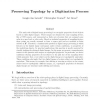Free Online Productivity Tools
i2Speak
i2Symbol
i2OCR
iTex2Img
iWeb2Print
iWeb2Shot
i2Type
iPdf2Split
iPdf2Merge
i2Bopomofo
i2Arabic
i2Style
i2Image
i2PDF
iLatex2Rtf
Sci2ools
JMIV
1998
1998
Preserving Topology by a Digitization Process
The main task of digital image processing is to recognize properties of real objects based on their digital images. These images are obtained by some sampling device, like a CCD camera, and represented as finite sets of points that are assigned some value in a gray-level or color scale. Based on technical properties of sampling devices, these points are usually assumed to form a square grid and are modeled as finite subsets of ZZ2 . Therefore, a fundamental question in digital image processing is which features in the digital image correspond, under certain conditions, to properties of the underlying objects. In practical applications this question is mostly answered by visually judging the obtained digital images. In this paper we present a comprehensive answer to this question with respect to topological properties. In particular, we derive conditions relating properties of real objects to the grid size of the sampling device which guarantee that a real object and its digital imag...
| Added | 22 Dec 2010 |
| Updated | 22 Dec 2010 |
| Type | Journal |
| Year | 1998 |
| Where | JMIV |
| Authors | Longin Jan Latecki, Christopher Conrad, Ari D. Gross |
Comments (0)

